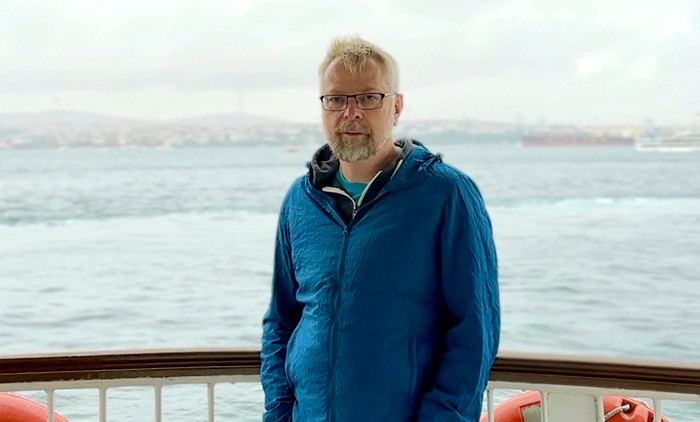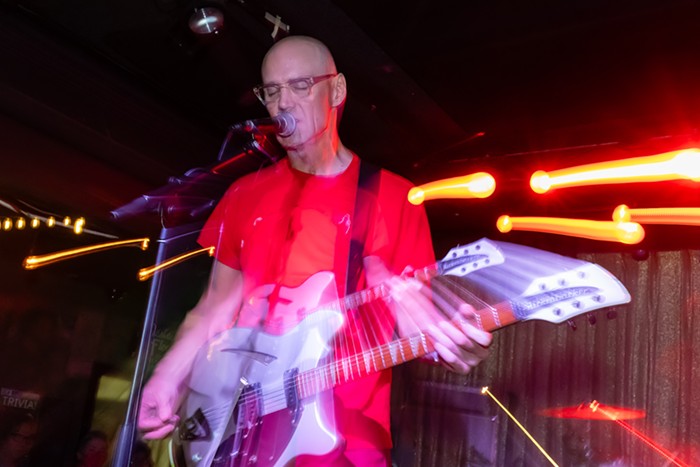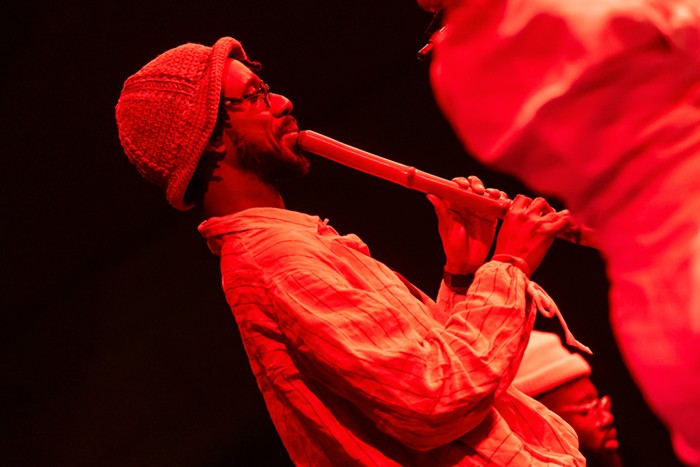The Infernal Noise Brigade died young. The funeral was a secret. It was held in the middle of the night in a gravel lot in Georgetown on July 29. Some mourners sat on top of an old school bus, but most stood on the uneven terrain, kicking up dust, getting their suits and dresses dirty, drinking whiskey or beer or homemade mead, rolling cigarettes, smoking joints, chewing chocolates packed with mushrooms, riding on each other's backs, taking flowers off the makeshift bar and jamming them into their hair, watching a montage projected onto a building, dodging the guy welded into and rolling around in a steel hamster ball. Several guys with power tools and metal blocks were showering the crowd with sparks. Behind them, a tall building with wooden railings and landings and doorways opened to red-lit rooms looked ghostly and carnivalesque.
Even though the funeral was not publicized, a very long entry line extended down Airport Way South. It was not publicized out of fear that the cops, historically hostile to the INB, would shut down the party. In the week leading up to the event, I got an e-mail from one of the percussionists asking me to "please PLEASE do whatever you can to keep this out of The Stranger." Reluctantly, I took the event out of Stranger Suggests; it seemed regrettable that a band whose most important and dramatic public events were standoffs with cops should be jittery about a standoff with cops. Wouldn't that be the perfect way to go?
The cops-to-marching-band hostility is, of course, mutual. The INB was founded during the WTO riots in 1999 specifically to stoke the flames of hostility toward Seattle's police force, and can be credited for keeping WTO protestors energized, focused, and photogenic. At that time, the band was a drum line, plus a few members whose jobs were tactical—carving out room in the crowds, doing reconnaissance, carrying flags—but after WTO the group grew to include cymbals and other percussive instruments, a horn section (trumpets, a trombone, a sousaphone, a saxophone), sound samples (stored in an iPod rigged to speakers), and singing (in English, Turkish, French, Czech, Spanish, Lebanese, and Portuguese, through a megaphone). The uniforms became more elaborate. The band's interests became global.
What began as a tear-gas dance with Seattle cops became a commitment to resisting authority around the world. INB made noise. They misbehaved. They had a rule at protests that if any of them got yanked out and arrested, the rest had to keep playing. Their political involvements took them to New York City (for the 2004 Republican National Convention; they were all arrested), Prague, São Paulo, Quebec, Paris, Cancún, and, last summer, to Scotland (they played in a field of barley outside the G8 summit while authorities on horseback surrounded them and helicopters buzzed overhead), London, Amsterdam, Brussels, Hamburg, Berlin, and cities in between. Some of those appearances were political actions, in which they played in solidarity with artist communities evicted at the hands of gentrification, but others were noisy, unhinged club shows or impromptu street parties. What their parties and their protests had in common was intensity, vividness, and a fun, frightening sense that anything could happen. They were lessons in liberation.
Seattle is going to suck without INB's parties. If the cops had shown up at the funeral any earlier than they did—around 5 a.m., just as rain was starting to fall and it was over anyway—they would have shut it down in a heartbeat. For their first set, the band marched through the crowd following a coffin borne on the shoulders of pallbearers. The coffin was set down, opened, drenched in kerosene, and lit. The flames were much taller than the crowd, roaring hellishly, reproduced in a thousand pairs of eyes. There were more flags and instruments than usual: Old members had flown in from around the world to play. In the silence between thundering songs, low-flying aircraft bound for Boeing Field screamed overhead.
The Infernal Noise Brigade was bound to crumble; nonhierarchical structures usually do. It was a mayfly, an original, an inspiring experiment. Its cause of death was suicide. It is survived by condos with corrugated siding, ballparks of fake grass, the mayor's anti-nightlife agenda, the Defense of Marriage Act, and the Seattle Police Department. ![]()



















